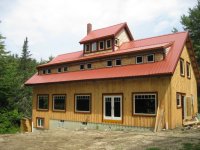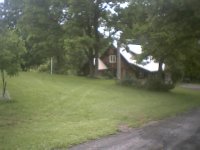shinnlinger
Silver Member
I have a sawmill and I have built alot of things with green lumber. from sheds to barns to houses
First off, many building inspectors say they only like inspected lumber, but they may not know the actual requirements for your area. I would first look up your local law and you can frequently find that a common sense inspection of the lumber is sufficient. ie, you do not put a huge knot in the middle of a beam or purlin, but you can probably get away with it in a post. I doubt this will be an issue for a machinery shed, but I wanted to post this so others may not give up the idea of using a local sawyer to mill up some trees you have on your property.
As for the lumber itself, alot has to do with species and how it was milled. White pine is very stable and if stickered as toy suggests, will serve you well, but it is also important that the sawyer "box the heart" on beams. That means you ideally want to see the center of the growth rings when you look at the end of the beam in the center of beam. by rolling the log as you mill you equalize the pressure and the timbers tend to stay pretty straight. IF I put a 26" diameter pine on my mill and start whacking off 2x's without rolling the log, I can pretty much guarantee you most of those 2x4's will be warped to uselessness. Many will curl up right on the mill. This is less of an issue with boards as they are narrower and have less stress. Trees that grew on hillsides can also be problematic
ON the subject of 2x's, they are a standard cut for big production mills. They have saws that will literally mill an entire tree into 2x all at once. Your local mill cannot compete with that so you may be sticker shocked if you get a quote on 2x4's. ON the other hand, boards and beams you cannot get at Home Cheapo, and that is where local mills can give you something unique at a good price. Even though I have a mill, I frequently buy my 2x4's and 6's from a building supply center.
As a rule, when I cut a timber frame, I cut it green. It is much easier and I want to get the timbers locked in place before they can warp. I will cut my tennons a little short or drill my mortices a little deeper so that when the timber does shrink it won't be much of an issue. If I were to pile a bunch of timber under tin for a few years, inevitably, some would warp and I would have to cut those timbers and wait a few more years or build or find a kiln.
Wood shrinks in width not length and as already been mentioned, it will shrink around a nail. Metal fasteners for rough cut are expensive, but I have welded my own custom brackets or even just drill holes in some steel plate to join timbers if you want a cheap and easy way. Your local machine shop will do this for you. I have a neighbor though who simple cuts the ends of beams to fit standard steel fastners. If you are having your lumber milled, you can ask the sawyer to cut to whatever you want. He or she would be happy to make you 3-9/16s by 3 and 9/16s and that will probably end up just right for a 4x4 fastener with EWP.
As for siding, I prefer board and batten. It is designed for green wood. You nail only one side of the board and then go back only nailing the center of the batten, so the wood can move the way it wants without splitting. I use ring shank nails. I have a big planer mill near me that sells seconds of KD shiplap for only .33 a board ft, which is only a whistle more than what I would charge you to cut YOUR trees, so look around.
First off, many building inspectors say they only like inspected lumber, but they may not know the actual requirements for your area. I would first look up your local law and you can frequently find that a common sense inspection of the lumber is sufficient. ie, you do not put a huge knot in the middle of a beam or purlin, but you can probably get away with it in a post. I doubt this will be an issue for a machinery shed, but I wanted to post this so others may not give up the idea of using a local sawyer to mill up some trees you have on your property.
As for the lumber itself, alot has to do with species and how it was milled. White pine is very stable and if stickered as toy suggests, will serve you well, but it is also important that the sawyer "box the heart" on beams. That means you ideally want to see the center of the growth rings when you look at the end of the beam in the center of beam. by rolling the log as you mill you equalize the pressure and the timbers tend to stay pretty straight. IF I put a 26" diameter pine on my mill and start whacking off 2x's without rolling the log, I can pretty much guarantee you most of those 2x4's will be warped to uselessness. Many will curl up right on the mill. This is less of an issue with boards as they are narrower and have less stress. Trees that grew on hillsides can also be problematic
ON the subject of 2x's, they are a standard cut for big production mills. They have saws that will literally mill an entire tree into 2x all at once. Your local mill cannot compete with that so you may be sticker shocked if you get a quote on 2x4's. ON the other hand, boards and beams you cannot get at Home Cheapo, and that is where local mills can give you something unique at a good price. Even though I have a mill, I frequently buy my 2x4's and 6's from a building supply center.
As a rule, when I cut a timber frame, I cut it green. It is much easier and I want to get the timbers locked in place before they can warp. I will cut my tennons a little short or drill my mortices a little deeper so that when the timber does shrink it won't be much of an issue. If I were to pile a bunch of timber under tin for a few years, inevitably, some would warp and I would have to cut those timbers and wait a few more years or build or find a kiln.
Wood shrinks in width not length and as already been mentioned, it will shrink around a nail. Metal fasteners for rough cut are expensive, but I have welded my own custom brackets or even just drill holes in some steel plate to join timbers if you want a cheap and easy way. Your local machine shop will do this for you. I have a neighbor though who simple cuts the ends of beams to fit standard steel fastners. If you are having your lumber milled, you can ask the sawyer to cut to whatever you want. He or she would be happy to make you 3-9/16s by 3 and 9/16s and that will probably end up just right for a 4x4 fastener with EWP.
As for siding, I prefer board and batten. It is designed for green wood. You nail only one side of the board and then go back only nailing the center of the batten, so the wood can move the way it wants without splitting. I use ring shank nails. I have a big planer mill near me that sells seconds of KD shiplap for only .33 a board ft, which is only a whistle more than what I would charge you to cut YOUR trees, so look around.
Attachments
Last edited:

